|
Background
In 1905 the Star Cycle Company
began to produce a low-cost range of cars, initially
under the ‘Starling’ name, adding a ‘Stuart’ model a
year later. Star already produced high quality,
expensive cars that were manufactured by the Star
Engineering Company. In 1909 this company took over its
parent company (The Star Cycle Company) and the
manufacture of ‘Starling’ and ‘Stuart’ cars ceased. They
were replaced by Briton cars, manufactured by the Briton Car Company under the
direction of Edward Lisle Junior, the son of Star's
founder. The new company had a capital of £50,000. |
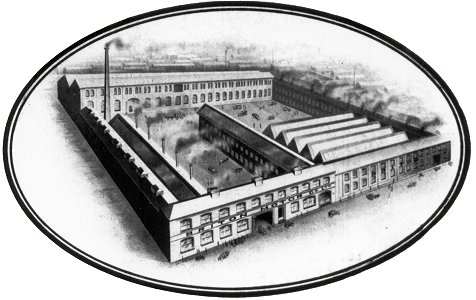
Stewart Street Works.
| Briton started life in the company’s Stewart Street
Works where the ‘Starling’ and ‘Stuart’ cars had been
built. The same workforce was employed, and the first
model, the two cylinder, 7 hp. (later increased to 10
hp.) ‘Little Briton’ soon appeared. It sold for 175
guineas. Other models quickly followed. There were four
cylinder 12hp., 14hp., and 16hp. cars, and in 1912 a 4
cylinder version of the10hp. car replaced the original
model. |
| Russell Jackson’s 10hp. Little
Briton from 1910.
As seen at the Festival of
Black Country Vehicles at the Black Country Living
Museum. |
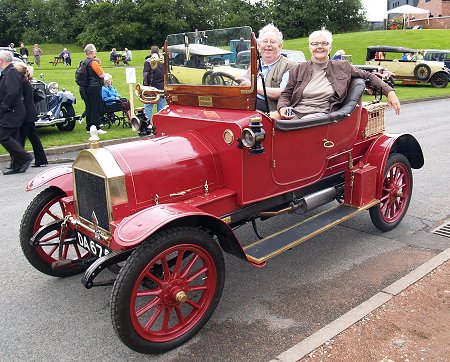 |
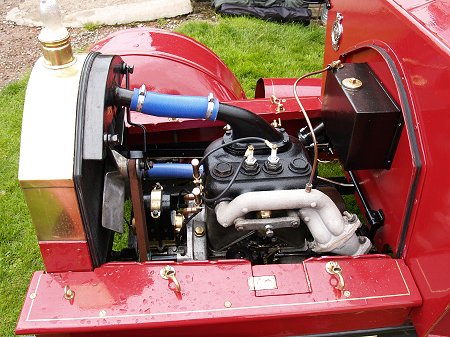 |
The engine in Russell
Jackson's Little Briton. |
| Another view of the engine in
Russell Jackson's Little Briton. |
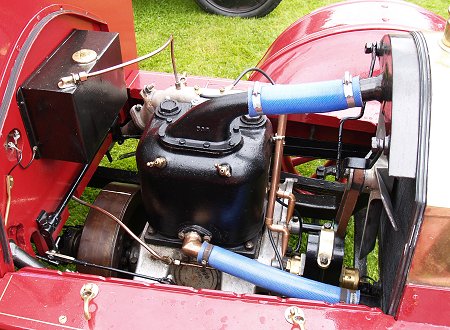 |
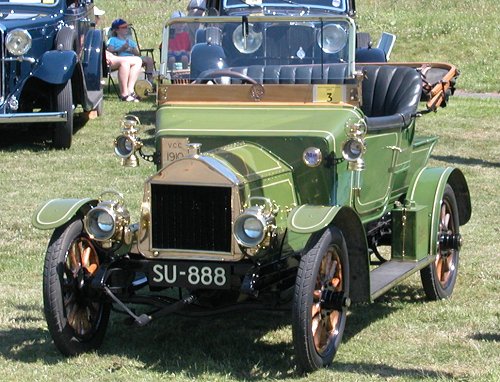 |
Tony Chesters' 12hp. Little
Briton from 1910. It is
very original, including the body. |
| In 1912 the Briton Motor Company (1912) limited was
formed and six acres of land were purchased between
Lower Walsall Street and Horseley Fields. The site had
previously been occupied by the northern half of
Shrubbery Iron Works. The company built a new factory on
the site, and moved there in 1913. The same year saw the introduction of the 10/12hp. and the
14/16hp. cars, and light commercial vehicles. |

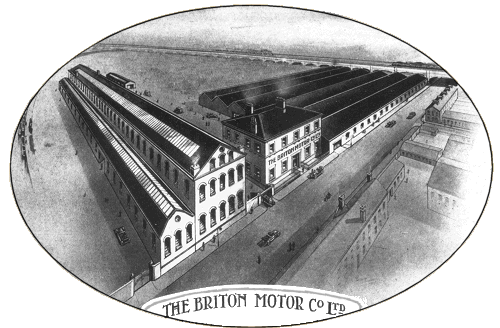
Lower Walsall Street Works.
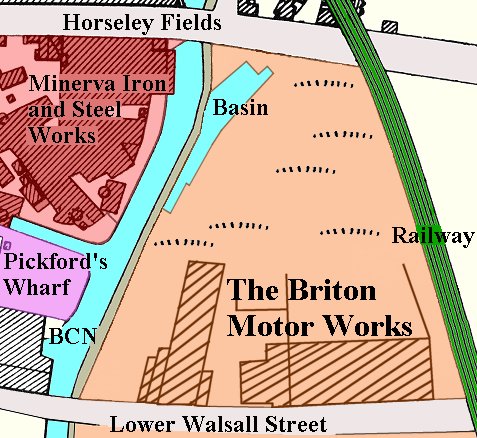
The location of the original factory, which
expanded to cover much of the site.

A plan of the factory from 1922, which then
covered over 70,000 square feet.
The Briton factory site covered an area over 3 acres.
The factory itself was extended to cover over 70,000 square
feet. The main entrance and general offices fronted onto
Lower Walsall Street. The two storey office block consisted
of the following:
Ground Floor: entrance foyer, manager's
office, repairs and sundries office, a telephone box, and
toilets.
First Floor: four partitioned offices with glazed
partitions, a storeroom, a telephone room, and ladies
toilets. |
Behind the office building was a lean-to boiler house
with a Quorn boiler, which fed hot water to the factory.
On the left-hand side of the entrance was a two-storey
brick building. The ground floor consisted of the saw mill,
the rough stores, and a kitchen. On the first floor was the
pattern shop, and foreman's office. Adjoining the building
on the western side, was the engine house. It contained a
40 hp. Crossley gas engine, a dynamo supplying 100 amps at
460 volts, and a large accumulator. There were also men's
and girl's toilets in the factory yard.
Next to the office building was the smaller of two
factory buildings. It consisted of six bays, brick-built,
with a north-light roof, measuring 135 feet by 133 feet. It
had a floor area of 17,860 square feet. It housed the body
shop, the paint shop, the varnish shop, and a stores. At the
back was a petrol and oil store.
Behind was a larger brick-built factory building with six
bays. It measured 252 feet by 180 feet and had a floor area
of 44,500 square feet. It housed the testing house, the
blacksmith's shop, the erecting shop, the engine and axle
shop, the machine shop, the tool room, a stores, the clerks'
offices, and a foreman's office.
At the back of the site along Lower Horseley Fields was
the canteen and kitchen, and the drawing office. Nearby was
the brick-built electric power house.
The London & North Western Railway ran alongside the
eastern side of the site on a viaduct with nine arches. The
arches were used as general stores and timber stores. |
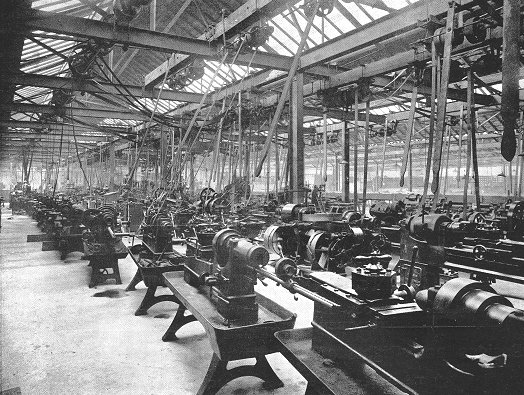
The machine shop.
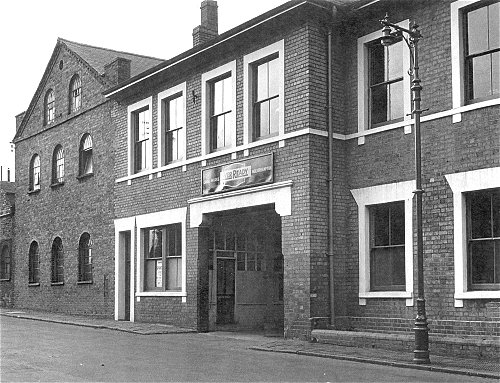
Lower Walsall Street Works. Possibly in the
late 1930s.
|
10/12hp., 4 cylinder, 68mm bore x 120mm
stroke, 1,743c.c. at 1,000 rpm: |
Price in 1913
|
| Standard chassis, pointed
radiator |
190 guineas |
| 2 seater |
235 guineas |
| 4 seater |
255 guineas |
| Special chassis, flat
radiator |
160 guineas |
| 2 seater |
175 guineas |
| 4 seater |
200 guineas |
|
14/16hp., 4 cylinder, 80mm bore x 120mm
stroke, 2,412c.c. at 1,000 rpm: |
|
| Standard chassis, flat
radiator |
225 guineas |
| 2 seater |
310 guineas |
| 4 seater |
350 guineas |
| Special chassis, pointed
radiator |
180 guineas |
| 2 seater |
200 guineas |
| 4 seater |
220 guineas |
|
| A Little Briton outside the
Whittington Inn. Courtesy of the late Charles Weight.
|
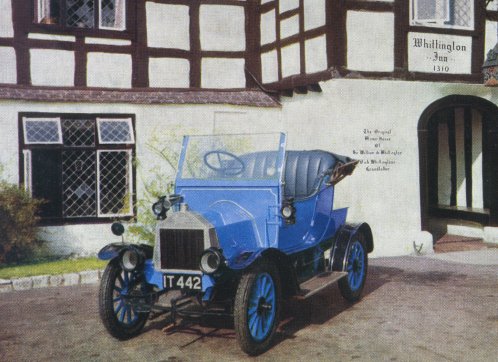 |
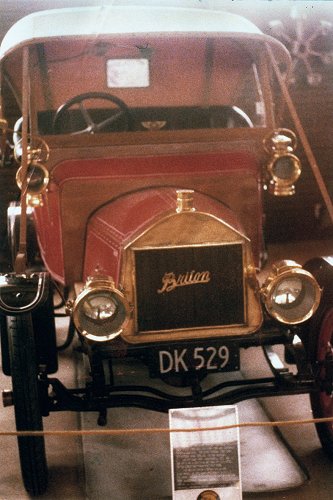 |
A Briton car seen in the
Queenstown Motor Museum, Otago, South Island, New
Zealand in 1978. Many Britons were exported to Australia
and New Zealand, and many of them still survive.
Courtesy of the late Charles Weight.
|
| Lord Montague of Beaulieu sold
this Little Briton for £250 in 1962 to the Measham Motor
Museum, near Tamworth. The last known owner is Mr. R. H.
S. Long of Crowle.
This car would have been
produced in Walsall Street Works.
Courtesy of the late Charles Weight.
|
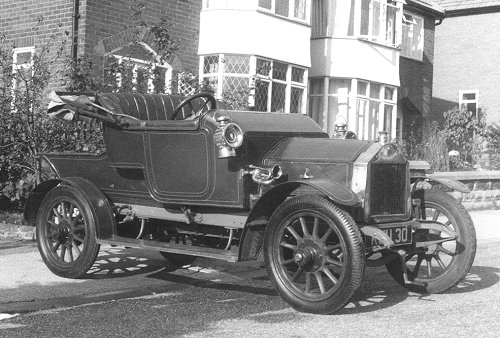 |
| |
|
Some interior views of
the
Briton factories |
 |
| |
|
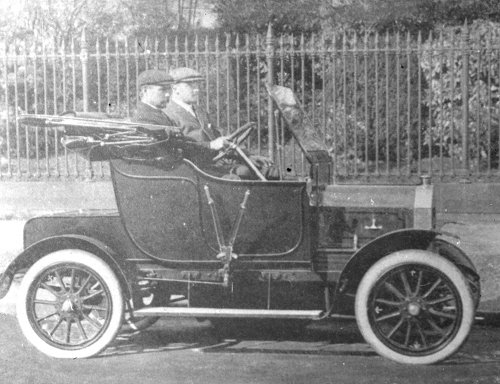 |
The Doctor's Victoria 10hp. 2
cylinder car. It sold for £215 in 1911 complete with
hood and screen. |
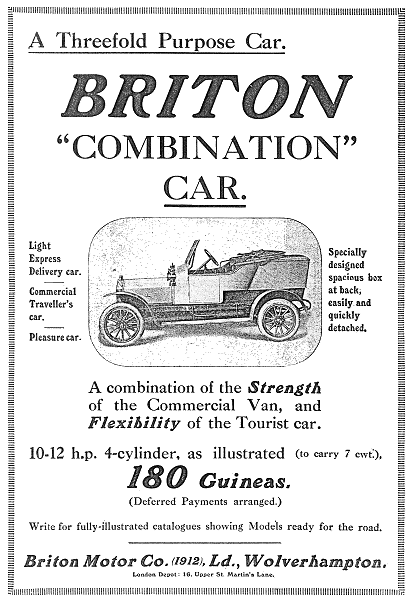
An advert from 1913.
| An advert showing some of the
trophies won by Briton cars, including the following:
Saltburn, 1912, Silver Cup and 2
gold medals.
Saltburn Speed Trials, Gold
Medal.
Brooklands - M.C. Handicap,
Silver Cup.
Brooklands - Second Raglan Cup.
Manchester Reliability Trials,
Gold Medal.
Coalport Hill, Gold Medal.
Irish Reliability Trials, Gold
Medal.
Rosslare Speed Trials, 1913,
Second.
Courtesy of Charles Weight. |
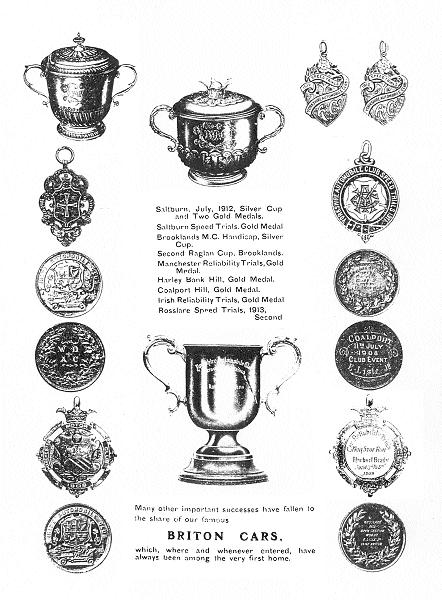 |
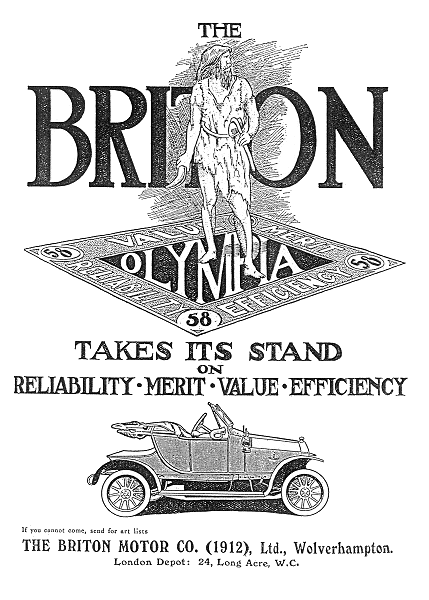
An advert from 1913.
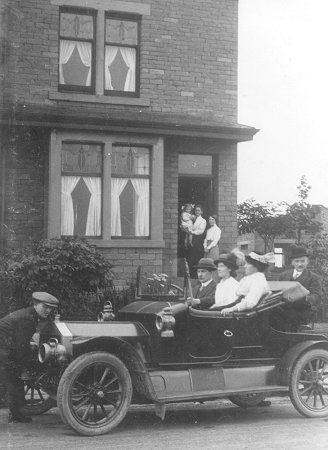 |
A 1911 four cylinder with
dickey seat and folding hood.
Note the wide body, allowing three
people to sit in what would otherwise be a two-seater;
the dickey seat in use; and the paraffin head and
sidelights.
Courtesy of the late Charles Weight. |
| |
|
| The 1912 Briton models |
 |
| |
|
| This 1912 Briton is seen in
Australia. Note the acetylene lamps and carbide water
generator on the near side running board. This car was
last heard of in 1967, owned by Philip Ironside of
Toorak, Victoria.
Courtesy of the late Charles Weight. |
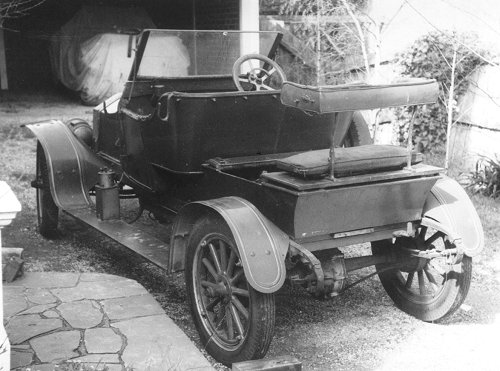 |
 |
|
 |
Return to the list
of manufacturers |
|
Proceed to World
War One and later |
|